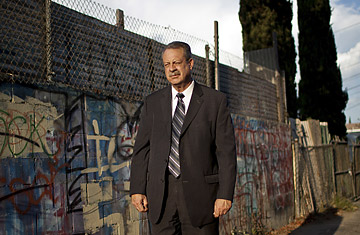
At 9:20 a.m. on July 7, 2010, undercover officers from the Los Angeles Police Department stepped out of an unmarked car and arrested 57-year-old Lonnie Franklin Jr. as he came out of his house on 81st Street at Western Avenue. He made no attempt to resist. The officers recited the charges: 10 counts of murder and one count of attempted murder, stretching back to 1985. By 10 a.m., 81st Street was cordoned off while six forensic teams searched Franklin's house and garage. They took away more than 900 items, according to subsequent grand jury testimony. In a bedroom, they found a .25-caliber semiautomatic pistol, later identified as the gun allegedly used to kill the last of the victims, 25-year-old Janecia Peters. In the garage, they found some one thousand photographs of women, many exposing their breasts for the camera. But even more dramatic than this pile of evidence was the way the cops found Franklin--by using his son's DNA.
I'd like to report a, uh--a murder, a dead body or something.
Where at?
The address is 1346 East 56th Street, in the alley. And the guy that dropped her off was driving a white-and-blue Dodge van, 1 PZP 746.
Did you get a look at him?
Uh-uh, I didn't see him.
How long ago did this happen?
It happened about--about 30 minutes ago, 'cause I'm down the street at the phone ... Like, he threw a gas tank on top of her and a--and the only thing you can see out is her feet.
What is your name?
Oh, I'm staying anonymous. I know too many people. O.K., then. Bye-bye.
The 911 caller was chirpy. It was as if he were making a social call. But what he said about the body was spot-on. When Sergeant Allan Seeget and Officer Robert Diaz of the LAPD walked down the alley with their Streamlight flashlights shortly after midnight that Saturday, Jan. 10, 1987, they found 23-year-old Barbara Ware's body facedown under a pile of trash and an empty gas tank. Only her white sneakers were sticking out. She had been shot 12 to 15 hours beforehand, the coroner later estimated. There was semen in her mouth and cocaine in her blood. The cops put her down as another victim of the crack-cocaine epidemic that raged through South L.A. from the mid-'80s to the mid-'90s, driving murder rates to record highs.
But Ware was not a crack killing, and her murder was the beginning of a nightmare for the LAPD. The police established that Ware's attacker was responsible for the deaths of six other women, all within a 2.5-mile radius, from 1985 to 1988. Then he appeared to stop, only to resume 14 years later, killing three more. And for two decades, the LAPD got nowhere on the murders. Leads petered out, while relatives of the victims accused the cops of dragging their feet because the victims were poor, young black women, many involved in drugs and prostitution.
